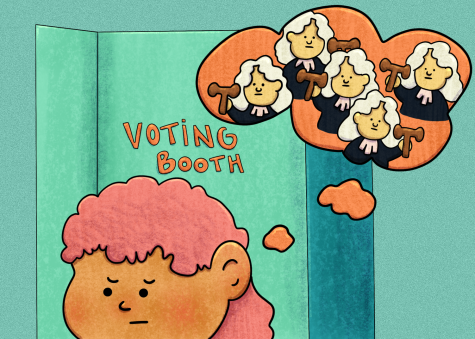Making sense of Cook County’s judicial elections
November 7, 2022

Illinois voters have a lot of decisions to make in Tuesday’s midterm election.
Down the ballot from the big ticket races for governor and U.S. Congress, sits a number of judicial candidates.
If words like “retention” or “appellate” leave your head spinning, or you are not sure how to make sense of the litany of names on the ballot, the Chronicle has done some research to help you make sense of it all.
How Judges are Elected
All judges must be at least 21 years old, a citizen of the United States, a registered voter, a licensed attorney in Illinois and a resident of the area they serve.
Judges first appear on the ballot during primary elections, where they run with party affiliation. If a judge wins their party’s nomination in that race, they appear on the midterm ballot.
Once elected, a judge does not have to run against an opponent every few years. Unlike a senator or an alderperson, a judge runs for retention, rather than reelection, at the end of their term. This means that voters simply check “yes” or “no” next to a judge’s name on the ballot, and if they get a three-fifths majority of “yes” votes, they remain a judge for another term. If a judge resigns, retires, loses their retention election or otherwise leaves the bench at the end of a term, their seat is distinguished on the ballot as a vacancy and a new judge can run to fill it.
In Illinois, there are three courts under the unified court system — the circuit court, the appellate court and the Illinois Supreme Court.
Circuit Court
Cases begin in a circuit court, or trial court. There are 24 judicial circuits across the state, and the Circuit Court of Cook County is the largest, with about 400 judges. In Cook County, judges run for circuit or subcircuit seats. There are currently 15 subcircuits and 5 will be added in 2024. Circuit judges serve six-year terms.
This year, there are 18 judges running for 17 vacancies across the subcircuits. All but one subcircuit vacancy election is uncontested — in subcircuit 13, there is both a Republican and a Democratic candidate on the ballot. There are 54 judges from the Cook County judicial circuit running for retention.
Appellate Court
When a case from the circuit court is appealed, it moves to the appellate court, where the ruling of the lower court can be upheld or reversed depending on the decision of the panel of three appellate judges assigned to a case.
The appellate court is divided into five districts, and Cook County comprises District 1.
Appellate judges serve 10-year terms. There are two Democrats in the running for two vacancies in the 1st District appellate court, and six appellate judges are up for retention this year.
The Illinois Supreme Court
The Illinois Supreme Court is the state’s highest court and has the last word on matters of state law. The court is made up of seven justices — one chief justice and six other judges. Three of those judges are from Cook County, and the remaining four are from one of the state’s four remaining judicial districts.
This year, seats from the 3rd and 2nd Districts are up for election. Cook County’s Justice Mary Jane Theis was recently appointed chief justice of the court. She is running for retention after first being appointed to the court in 2010 and winning a partisan election for a full term in 2012.
Researching Candidates
There are several resources out there for voters who want to learn more about the judges on the ballot.
Voteforjudges.org, which is run by the Chicago Appleseed Center for Fair Courts, is a voter guide that compiles the bar association evaluations of the Alliance of Bar Associations for Judicial Screening.
A bar association is a professional organization of lawyers, and its evaluation is like a grade, indicating whether the group believes a candidate is qualified or recommended for the position they are running for.
“When we’re asked on the ballot if we’re going to retain a judge who may have been sitting on the bench for 16 years, but we have no public information about that judge, I don’t know how someone can make an informed decision,” said Stephanie Agnew, communications director for the Chicago Appleseed Center for Fair Courts.
Evaluations, she said, can bring out information to the public that is usually limited and available to just lawyers and judges.
Made up of 12 different bar associations, the Alliance of Bar Associations for Judicial Screening evaluations cover the candidates running in Cook County. Voteforjudges.org also includes links to detailed reports on the candidates from the Illinois State Bar Association and the Chicago Council of Lawyers.
Judges are the elected officials the average person is most likely to come into contact with, says Injustice Watch managing editor Jonah Newman. But there is an “information gap” when it comes to the judiciary that the nonprofit aims to fill with the new site’s nonpartisan voter guide.
The Injustice Watch judicial voter guide includes information about a judge’s past experience, bar association ratings and the salary of each judge up for retention. It also includes any notable decisions a judge has made or past controversies they have been involved in.
“There are so many things about the system that are really not transparent, and I think we’re trying to bring some levels of transparency and accountability to it,” Newman said.
The Injustice Watch judicial voter guide is available online, and physical copies are available at various Chicago Public Library locations and in local papers such as The Chicago Reader and Austin Weekly News.







